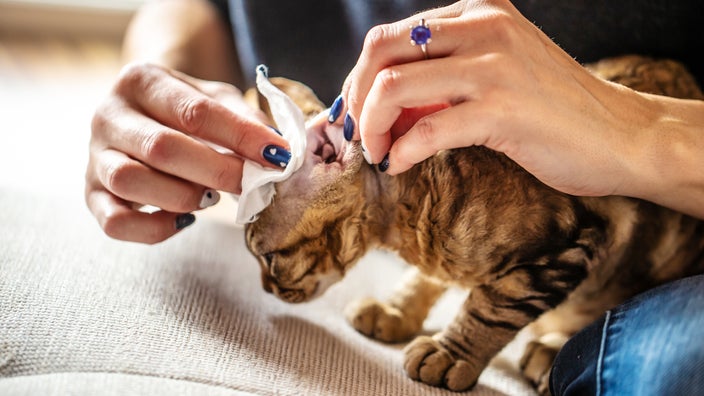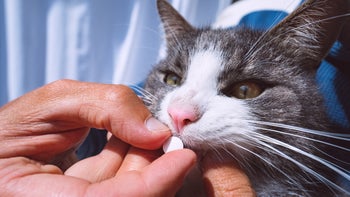
How (and When) to Clean a Cat’s Ears
Key takeaways:
Many cats don’t need their ears cleaned. But cats with a lot of wax buildup may benefit from ear cleaning to help prevent infection.
You can safely clean your cat’s ears at home. But follow some key steps and only use products specifically designed for cats.
If you spot potential health issues, like ear mites, during the cleaning, your cat will need to see a vet.
Table of contents

Just as you groom your cat and perform regular nail trims, you may need to give your cat’s ears some care, too. Regularly inspecting and cleaning your cat’s ears may help to prevent infections. Plus, it gives you an opportunity to spot and treat potential health issues early on.
How do you clean your cat’s ears?
If your cat needs regular ear cleanings, you can learn how to safely do this at home.
The first step to cleaning your cat’s ears is to gather the appropriate supplies. You’ll need:
A cat-specific cleaning solution
Cotton balls or gauze
A towel
Save on the top 10 pet medications
Save big on common pet medications like Fluoxetine and Levetiracetam at your local pharmacy.

GoodRx is NOT insurance. GoodRx Health information and resources are reviewed by our editorial staff with medical and healthcare policy and pricing experience. See our editorial policy for more detail. We also provide access to services offered by GoodRx and our partners when we think these services might be useful to our visitors. We may receive compensation when a user decides to leverage these services, but making them available does not influence the medical content our editorial staff provides.
Once you have everything ready, you can clean your cat’s ears at home by following these steps:
Sit in a comfortable position and hold your cat in your lap.
Swaddle your cat in a towel, which will help keep them from moving or scratching you.
Grasp the tip of one of their ear flaps and pull it back slightly to straighten the ear canal.
Apply a few drops of ear cleaning solution to the inside of your cat’s ear flap. Avoid putting the tip of the bottle into their ear canal, since forcefully squeezing the bottle while it’s anywhere in their ear could rupture their eardrum.
If the tip of the bottle touches your cat’s ear, you will need to clean it to prevent yeast from spreading. To do this, soak a clean cotton ball in alcohol and wipe off the tip of the bottle. Do not use alcohol on your cat’s ear.
Massage the base of your cat’s ear for 20 to 30 seconds to help distribute the solution throughout their ear canal.
Hold their ear flap and use a cotton ball or gauze to wipe away any debris.
Let your cat shake their head, which will move any remaining ear cleaning solution and debris out of their ear canal and toward the outer ear opening.
Clean the inside of their ear with a dry cotton ball.
Praise your cat and offer them treats.
Repeat the process with the other ear.
Depending on your cat, it may be easier to have a second person hold them while you clean their ears, suggests Alex Schechter, DVM, who works at Burrwood Veterinary in Michigan.
“Offer treats throughout the process to reward your cat and help them have a positive association with ear cleanings,” he added.
If you spot an issue while checking your cat’s ears, or your cat won’t tolerate at-home cleanings, your veterinarian can do a cleaning.
How do you clean a kitten’s ears?
Cleaning a kitten’s ears is no different than cleaning a grown cat’s ears. You may need a bit more patience because a younger pet may be more playful and more resistant to cleanings.
Vet care: How often should your cat see a vet? Once or twice a year, or maybe more, depending on their age and health.
Normal vs. excessive licking: Cats lick themselves for a variety of reasons, from grooming to cooling off. But is your cat’s licking out of control? It could be pain or anxiety.
Brushing: Cats need their coats groomed, and it’s a great way to bond with them. Spoil them with a good brushing at home.
Wrapping your young animal in a towel should keep them from moving around too much. Remember to offer them treats and praise them so they associate ear cleaning with rewards. And if necessary, find someone to cuddle them while you clean.
When should you clean your cat’s ears?
Checking your cat’s ears is an important part of routine cat care. During these inspections, you should look for dirt and wax buildup, which can potentially lead to infection. If you don’t spot any issues, you don’t need to worry about doing a cleaning.
Schechter points out that cats are meticulous groomers. As a result, most of them do just fine without any ear-cleaning help.
Read more like this
Explore these related articles, suggested for readers like you.
Still, he recommends looking inside your cat’s ears at least once a week. If you notice discharge or a foul odor, their ears need to be cleaned.
“If your pet is prone to wax buildup and ear infections, ear cleaning can be an essential part of your cat’s hygiene needs,” Schechter told GoodRx Health.
Depending on the extent of the issue, you might need to go to the veterinarian instead of cleaning your cat’s ears at home.
“If the ears are red, inflamed, or painful, consult your veterinarian before cleaning,” Schechter recommended.
How do you clean the ears of a cat that has ear mites?
Ear mite infestations can cause a lot of waxy buildup in your cat’s ears. A cat that has ear mites will need ear cleaning and treatment. To treat ear mites, your vet might recommend:
A topical ear medication like Tresaderm
A course of treatments using ivermectin
Single-use prescription products like milbemycin oxime (Interceptor)
What common mistakes do people make when cleaning a cat’s ears?
Well-meaning pet parents sometimes make mistakes when cleaning their cat’s ears, according to Schechter. Here are some things to avoid.
Hydrogen peroxide
Schechter said that many pet owners use hydrogen peroxide to clean their cat’s ears. But hydrogen peroxide can dry out ears. Instead, it’s important to use an ear cleaning product specifically designed for cats.
Products with alcohol
Avoid using any products intended for humans and those that contain alcohol, which may irritate your cat’s sensitive ears.
Overcleaning
Schechter also encourages pet owners to avoid overcleaning their cat’s ears. Overcleaning may irritate a cat’s ear canal and lead to infection. So only clean your cat’s ears if you notice buildup, discharge, or a foul odor.
Cotton swabs
Avoid using a cotton-tipped applicator to clean your cat’s ears. Schechter explains that these types of applicators can potentially puncture your cat’s eardrum or cause trauma to their ear canal. Cotton-tipped products can also push debris further into the ear canal. A cotton ball or piece of gauze is a much safer choice.
Why can it be difficult to clean your cat’s ears?
Cleaning your cat’s ears can be tricky and takes some practice, Schechter said. But it’s important to avoid doing cleanings if your cat is anxious or fighting you.
An ear disease, like an ear infection, can be very painful and make it difficult for your cat to tolerate inspections and cleaning. If this is the case, your cat will need to go to the vet for examination and cleaning.
Be sure to monitor how your cat handles inspections and cleanings. If you encounter issues, it’s best to involve your vet. “If your attempts at cleaning your cat’s ears appear to be causing them distress, don’t persist, as this could result in ear damage,” Schechter said.
When should you see a vet about your cat’s ear problems?
Cleaning your cat’s ears at home can be a critical part of keeping them healthy. But it’s important to recognize when your cat needs veterinary care. There are several ear diseases that need more specialized care than you can provide at home.
Otitis externa, for example, is a condition that can occur when your cat’s external ear canal becomes inflamed. Common symptoms include:
Head shaking
Red skin
Swelling
Discharge from the ear
Scaly skin
Scratching at the ears
Otitis externa can be uncomfortable and even painful. If your cat develops this condition, your vet may clean your cat’s ears and prescribe topical ear medication. They might also give your cat medication by mouth or injection to help relieve the inflammation and discomfort.
Frequently asked questions
There’s no set schedule for cleaning your cat’s ears. It all depends on what you find during your routine cat care. If you see dirt, wax buildup, or ear mites, it’s time to clean their ears.
Generally, it’s best to use an ear cleaning solution formulated for cats. But some experts say it is safe to use warm water on a cotton ball to rinse off any residue on your cat’s ears once you’re finished cleaning. However, don’t pour warm water into your cat’s ear canal, as this can be harmful.
It’s not safe to use Q-tips to clean your cat’s ear because they can damage their ear canal or ear drum. Safer options are cotton balls or gauze pads.
The bottom line
Most cats don’t need their ears cleaned regularly. But, even if you don’t need to clean your cat’s ears often, it’s a good idea to do an inspection once a week. Regular ear inspections can help you spot potential health issues early on and get your cat treated before things get more serious. And if you do need to clean your cat’s ears, use cat-specific ear cleaning solutions and cotton balls or gauze.
Why trust our experts?



References
Brooks, W. (2022). Ear mites in dogs and cats. Veterinary Partner.
Cornell Feline Health Center. (1996). Feline forum: Ear care basics.
Moriello, K. A. (2018). Otitis externa in cats. Merck Veterinary Manual.
Veterian Key. (2016). Examination of the external ear canal.
Washington State University College of Veterinary Medicine. (2022). Examining and medicating a cat’s ears.
Woodward, M. (2020). Otitis externa in animals. Merck Veterinary Manual.





























